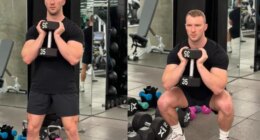
Building muscle doesn’t have to mean lifting super heavy or always picking the most challenging exercises. Another way to level up your strength training? Incorporate a drop-set workout into your routine.
The drop set is a brief-but-effective weight lifting technique that will seriously challenge your muscles and help you achieve hypertrophy, or muscle building.
Personal trainer Evan Williams, CSCS, founder of E2G Performance in Chicago, tells SELF he does drop-set workouts once or twice a week with most of his clients. This technique, he says, delivers a good bang-for-your-exercise buck.
Curious to know more about drop sets, their benefits, and the best way to work them into your routine? We’ve got all that—and more—below. Then, if you want to try a drop set yourself, we have an example workout from Williams that you can do today to totally smoke your arms.
First though, a quick caveat: Drop sets are an advanced weight lifting technique, so you should only attempt them if you’re already familiar and comfortable with traditional strength training—more on drop-set safety in a minute. With that in mind, keep scrolling for all the must-know intel!
What do we mean by drop sets?
A drop set is a weight lifting technique where you pick one exercise and do reps of it with a certain weight until “failure”—meaning, your muscles are so tired there’s no way you could do another rep with good form. Then, you decrease the amount of weight you’re using and do another set until failure. Then, you decrease the weight once more and repeat until failure for a final round.
READ RELATED: The 17 Best Walking Shoes for Long Strolls and Quick Errands
In a drop set, there’s no rest. “The only rest you take is the time it takes you to change the weight,” says Williams.
What are the benefits of drop sets?
If your goal is to build muscle, drop sets can be a technique to help you get there, since they help you work your muscle until failure, says Williams. According to a 2018 study published in the Journal of Strength & Conditioning Research, drop sets may stimulate growth of your slow-twitch muscle fibers. Because these slow-twitch muscle fibers are endurance-based, it takes more time under tension to trigger muscle growth in them—and drop sets are great for providing higher time under load. Working your muscles to failure also encourages more nutrient dense blood flow to the area, which in turn helps your muscles grow, Williams explains.
Basically put, drop sets are great for building bigger, stronger muscles. Research backs this up: A 2016 study of aging adults found that drop-set training improved muscle mass, strength, endurance, and functionality. And a small 2018 study involving eight men found that a single set of drop-set training may lead to better muscle gains than three sets of conventional resistance training, likely because of the increased stress that drop-set training places on the body.
Drop sets are also a really efficient use of your time. “If you’re in a time crunch, it gets a quick workout in,” says Williams. “It’s an easy way to maximize your muscles without spending a lot of time on that particular muscle group.” Lastly, drop sets are a good way to ensure you’re constantly challenging yourself, since the whole point of the drop set is to work your muscles to failure. That focal point encourages you to keep progressing your workouts as you get stronger so that you’ll continue to move forward toward your fitness goals.
What’s the best way to use drop-sets?
Drop-sets are best performed with isolation exercises (i.e. movements that target just one joint and muscle group, like bicep curls, tricep extensions, leg curls, and calf raises), says Williams. Compared to compound exercises which involve multiple joints and muscle groups working (think squats and deadlifts), isolation exercises have a lower risk for injury in a drop set. That’s because they are less complex—there’s more room for form errors in compound exercises when you get fatigued, which can be dangerous. Also, in many cases it’s easier to safely drop your weight and stop doing an isolation exercise in the event your muscles give out unexpectedly. For example, it’s much easier to stop doing a dumbbell biceps curl mid-rep vs. a barbell back squat mid-rep.
Source: https://www.self.com






